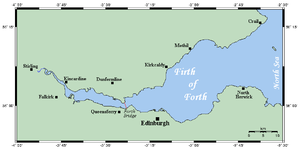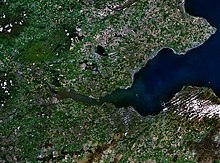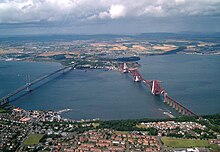Firth o Forth



The Firth o Forth (Scots Gaelic: Linne Foirthe) is the estuarie or firth o Scotland's River Forth, whaur it flowes intil the German Sie. Til the north ligs the coontie/coonsil area o Fife an til the sooth ligs the Fawkirk, Ceety o Edinburgh, Wast Lowden an East Lowden coonsil areas.
Mukkil touns an ceities on or naur the shore include Kirkcaldy, Fawkirk, Stirlin, Musselburgh, Alloa, Grangemooth, Buckhyn, Inverkeithin, Bo’ness, Queensferrie, North Barwick an the Scots heidtoun, Edinburgh.
As weil as touns an ceities, thar ar monie industrial steids on its shore. Thir includes the petrochemical plaunt at Grangemooth, the commersial docks at Leith, umwhyl aylrig biggin yairds at Methil, the ship-brekin faseilitie at Inverkeithin an the naval dockyaird at Rosyth.
The Forth Road Brig, Forth Railwey Brig an Kincardine Brig cairrie traffec athort the Firth. The Clackmannanshire Brig, neist the Kincardine Brig, apen’d in 2008.[1]
Geologicalie, the Firth o Forth is a fjord, shapit bi the Forth glacier in the last ice eild. The river is tydal as ferr inland as Stirlin, but the mairch atwein the river an firth is forordnar held ti be at Kincardine Brig. The inner Firth (atwein the Kincardine an Forth brigs), haes lost aboot hauf o its foreshore (intertydal aurie) as an affcum o land bein reclaim'd. This wis pairtlie for fermin, but maistlie for industrie an the mukkil ess lagouns biggit ti stell the spoil frae the coal fyr'd Longannet Pouer Station.
The Firth is important for naitur hainin an a Steid o Special Scientific Interest. The Firth o Forth Ilands Special Protection Aurie is host ti ower 90,000 breedin siebirds ilka yeir. Thar is a bird watchhouss on the Isle o May.
Ilands o the Forth
[eedit | eedit soorce]| Iland | Name meinin an springheid | Aurie (ha)[2] | Heichest pynt[3] | Last bidden |
|---|---|---|---|---|
| Allowae Inch | frae the Gaelic innis (iland) an Alloa (a naurby toun) | ~33 | <5 meter | 20t centurie? |
| Bauss Rock | belyk frae Gaelic bathais, meinin "foreheid"[4] | 7.5[4] | 107 m | 1970s[4] |
| Craigleith | frae Gaelic Creag Lìte meinin "rock o Leith" | 5 | 24 m | niver |
| Cramond | belyk frae Brythonic Car Amond meinin "fort on the Almond River"[5] | 7.7 | 28 m | belyk Warld War II |
| Fitherae | frae the Auld Norse for "fether iland"[6] | 10 | 20 m | 1970[7] |
| Inchcoam | frae the Gaelic Innis Choluim meinin "Colum's iland" | 9 | 34 m | haes indwallers |
| Inchgarvie | frae the Gaelic Innis Garbhach meinin "roch iland" | 0.83 | 19 m | belyk Warld War II |
| Inchkeith | belyk frae the Gaelic Innis Cheith or Innis Coit;[8][9] the seicont pairt o whilk micht be frae the Brythonic "coed" meinin "wid"[8] | 20 | 59 m | 1986 |
| Inchmickerie | belyk frae the Gaelic Innis nam Bhiocaire meinin "iland o the vicar" | <5 | 14 m | belyk Warld War II |
| The Lamm | 0.5 | 15 m | niver | |
| Isle o Mey | belyk frae the Gaelic Eilean Mhàigh meinin "iland o the plain" | 45 | 50 m | 1989 |
| Tullibody Inch | frae Gaelic innis (iland) an Tullibody (a naurby toun) | 6 | <5 m | unkent |
Referenses
[eedit | eedit soorce]- ↑ BBC news report, 1 October 2008
- ↑ Estimate frae Ordnance Survey cairts unless kyth'd itherweys.
- ↑ Ordnance Survey
- ↑ a b c Haswell-Smith (2004) p. 495
- ↑ Mac an Tàilleir (2003)
- ↑ Ryder, N.L. "Displacement of bone waste by seagulls" Archived 2011-09-27 at the Wayback Machine (pdf) Circaea: The Bulletin of the Association for Environmental Archaeology. 6 No. 2 (1990) University of York. p. 85. Retrieved 19 September 2010.
- ↑ "Fidra". Gazetteer for Scotland. Retrieved 18 June 2008.
- ↑ a b Watson (1926) pp. 381-82
- ↑ "The Life of Saint Serf" cyberscotia.com. Retrieved 27 Dec 2010.
